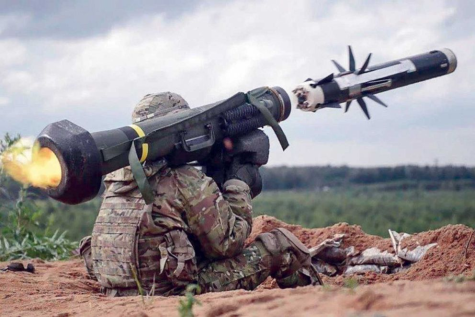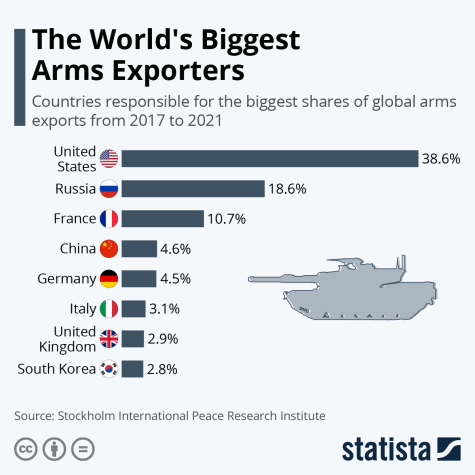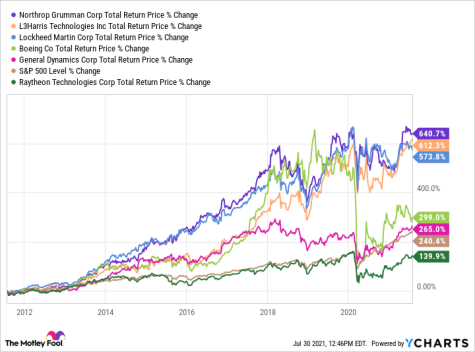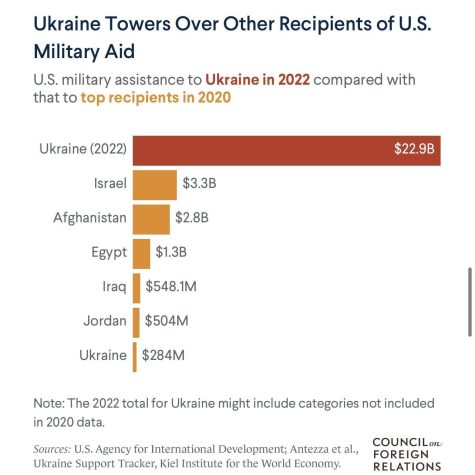Merchants of Death
February 16, 2023
As the war in Ukraine nears the one year mark, the amount and nature of aid the country has received is yet another depiction of the United States’ inclinations to profit off of war.
Our support of Ukraine against Russian invasion is a continued example, following the footsteps of our aiding groups like the Mujahideen or Afghan National Army and nations like Saudi Arabia and Syria. No, I do not believe we shouldn’t help other countries, especially when they are invaded unfoundedly by a stronger country, but our eagerness to help and the amount of times we have done it, along with the money we make off of our support, are more the issue.
Plainly speaking, the war in Ukraine has been a proxy war for the United States. Our involvement is beyond assistance. We’ve been testing our logistics and technological capabilities on a modern, distant battlefield, learning about the direction in which modern warfare is heading and burning through our old military hardware.
The asymmetric warfare the world has witnessed in Ukraine has shown us that our own military developments may be slightly flawed. A large portion of our military research and funding has gone to tanks, like the Abrams, and the development of new generations of aircraft.
Mechanized and aerial units in Ukraine have been countered by shoulder-mounted rockets, ground-based air defense systems and kamikaze drones, all of which are a fraction of the price and much easier to operate than armor and aircraft. In the coming years, we are likely to see the direction of our military spending shift. Ukraine has received over 5,500 Javelins as of May 2022. We have been producing between 600-800 annually.

Mark Cancian is a former Marine Colonel; In an interview with NPR, he touched on our aid to Ukraine.
“Well, the Javelin has become the iconic weapon of the war. It caught everyone’s imagination,” said Cancian. “The reason I think it caught people’s attention is because the Russians have a very mechanized military…they’re also very good for a military that may not be all that well trained.”
The Javelin missiles in particular have made eye-opening differences in the conflict because of their top-down trajectory option, allowing for the targeting of the thinner armor on top of the turreted vehicles.
The Ukrainian forces have been able to, in small groups without armor and air support, sneak up on and destroy vast amounts of armor, showing that mechanized units are not the Achilles heel of lone infantry units.
Similarly, in the air, Stinger missiles have been giving the Ukrainians the ability to counter Russia’s numerically and technologically superior Air Force. Ukraine came into the war with a largely outdated Air Force, including many Cold War-era MIG’s.
These infrared homing missiles can be fired by one soldier and are strong enough to take down helicopters, transport planes and drones. Similar surface-to-air systems have also been employed to take down fighter planes. Ukraine has seen a vast reduction in air-to-air engagements.
Russia has been seen as America’s chief competition on the global stage since the end of World War Two. The war has given a way for us to pit ourselves against Russia without starting a war directly with them. We’ve learned that Russia is not the threat that they were perceived as pre-invasion. The real challenger is China, evident in the policy shifts of the Biden administration, and their being described by the FBI as our top threat to national security.
Our involvement in Ukraine has more sides than just assistance, but the lessons we are learning are undoubtedly beneficial. The deeper issue lies in the money surrounding our interventions.
Prior to World War II, America was reeling from the effects of the Great Depression. The industry needed to participate in, and ultimately win, the war, which would be the remedy to our financial woes.
The U.S military-industrial complex is the reason for our catapult to the top spot on the global stage after the second World War. The increase in production that we needed to defeat the Axis powers resulted in a very rich America with a massive amount of weapons along with modernized capability for production of all sorts.
This economic boom is also due, in part, to our coming out of the war relatively untouched . In terms of the homeland, only Hawaii was damaged, meaning that while Europe, Asia and Africa were having to rebuild large portions of industry and their countries as a whole, we were able to focus on economic growth and transitioning the militaries’ advancements into areas that could benefit the public.
The term military-Industrial complex was actually popularized by President Eisenhower, one of the great generals of World War II, in his 1961 Farewell Address. Eisenhower made a point in his presidency of keeping the military, specifically the spending and industry surrounding it, in check
“In the councils of government, we must guard against the acquisition of unwarranted influence, whether sought or unsought, by the military-industrial complex,” said Eisenhower. “The conjunction of an immense military establishment and a large arms industry is new in the American experience.”

Currently, some of the biggest defense contractors are Raytheon, Lockheed Martin, Boeing and Northrop Grumman. Since the beginning of the war, all of these companies have seen either a substantial increase in the price of their shares, or high profits.
Raytheon is headquartered in Arlington, Virginia and is mainly focused on aircraft engines, intelligence, aerospace advancements and missile technology. Many of the rockets that have been turning the tide in Ukraine’s favor come from Raytheon, namely the Javelin, Stinger, TOW anti-tank missiles and the NASAM and HAWK surface to air missiles.
Boeing, headquartered in Chicago, is the maker of many civilian aircraft, but they make a large portion of their money working with the government. Ukraine has benefited from Boeing’s Avenger Air Defense Systems, ScanEagle drones and the Harpoon anti-ship missiles.
Lockheed Martin is the newest out of the previously mentioned Raytheon and Boeing, being founded in 1995, headquartered in North Bethesda, Maryland. Lockheed makes the Javelin missiles and the HIMARS multiple rocket launcher. Ukraine’s president, Volodymyr Zelensky, has been in talks to receive F-16 jets, which, should he receive, are made by Lockheed as well.
Northrop Grumman is largely responsible for the manufacture of ammunition, which has been a very large portion of the aid that Ukraine has received. The end of 2022, for example, saw a $400 million aid package of ammunition and generators.
Raytheon shares were valued at $82.28 December of 2021; now, their shares are evaluated at $97.65. Lockheed was priced at $347.02 on Dec. 23 2021, and is currently at $469.65, Northrop Grumman was valued around $382 a share in Feb. 2022; currently, a share costs $464, peaking at nearly $550. Boeing is the only one of the four that has not seen an increase in their share price but still had a 15.78% increase in their profits for 2022.

The contractors themselves are getting large returns for their assistance to Ukraine since they are getting massive government contracts, but the stock returns are the real issue.
The people who hold shares in these companies are receiving returns due to this war much greater than the returns of the market on average. Warren Buffet’s portfolio averages a 9.34% annual return. If someone was to invest solely in these four defense contractors, they would put to shame Buffet and any other professional investor, let alone the market or more casual ones.
Since military operations began in Afghanistan in 2001, the stocks of the top five defense contractors have seen almost 900% growth on average.
Everyone who owns a share of these companies profits off of death, quite troublesome, but it gets deeper upon analysis of who owns the shares.
Our policymakers themselves have very large holdings in the business of defense contracting, which is at the very least a conflict of interest. This is similar to the habits of Congress we saw during the pandemic, when they would purchase shares of companies that would be receiving government contracts, contributing to one of the greatest upward transfers of wealth in American history.
According to Sludge, near the end of 2021, at least 11 senators and 36 representatives held somewhere between $2-6.7 million in the top 100 defense contractors. In financial disclosures for Congress’ investments, the exact numbers are not given, the reason for such a large range.

As the war in Ukraine was approaching its opening, many of our representatives were set up to profit from the event. Last May, Congress approved a $40 billion defense package to Ukraine; our elected officials were more than prepared, to say the least.
Rep. John Rutherford, R-FL invested up to $15,000 in Raytheon on Feb. 24, 2022, the day Russia invaded Ukraine. Rep. Marjorie Taylor Greene, R-GA bought up to $15,000 in Lockheed on Feb. 22, 2022. Rep Lois Frankel, D-FL sold up to $15,000 of Lockheed stock in January, still retaining more shares, while Rep. Diana Harshbarger, R-TN and her spouse made three trades of Lockheed shares valued up to $15,000 each that month as well.
Sen. Deb Fischer, R-NV inherited between $50,001 and $100,000 in Lockheed shares on Dec. 26, 2021. Sen John Hickenlooper, D-CO possessed between $100,000 – $250,000 in Raytheon stock. Sen. Sheldon Whitehouse, D-RI held shares in both Lockheed and United Technologies, which was acquired by Raytheon. Sen Shelley Moore Capito, R-WV held up to $15,000 in Lockheed shares. Sen. Gary Peter, D-MI possessed up to $15,000 Raytheon as well.
And the list goes on. What’s most troubling is that multiple lawmakers with holdings in the defense industry also sit on subcommittees. Sen. Peters is on the Committee on Homeland Security, Sen. Fischer serves on the Senate Armed Forces Subcommittee and Rep. Rutherford has a seat on the House Appropriations Committee, which is in charge of federal spending.
Through giving aid to foreign armies and involving ourselves in conflicts worldwide, our politicians and the upper class are able to live more than comfortably through the returns they receive through stocks, among other methods, which they are led to invest in due to their knowledge of military plans and contracts down the line.
We have continually seen throughout American history how eager we are to ramp up our industry, get involved in matters halfway across the world, and then a small populationally unrepresentative group reaps the economic benefits.
This is not an under-the-radar issue; there are laws and regulations surrounding the owning of stocks by Congress. Clearly they are not working. Now, the idea that our elected officials should not be able to invest in stocks at all is being bounced around.
“Merchants of Death” is not a new term, but it is one that aptly describes these companies and, furthermore, these politicians. Their will to act like this behind the guise of financial wisdom and upward mobility through investing, while telling the populace that they are anti-war, is astounding and is the kind of boldfaced contradictions that have become all too common in our politics.
The ability to make money directly off of the suffering and death of others seems like something straight out of a dystopian movie. Sadly, it is not fiction, but our reality in America.


